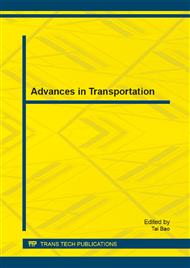[1]
J. Dahl, and C. Lee: Transportation Research Record Vol. 2312(2012), p.34.
Google Scholar
[2]
X. Qu, L. Ren, S. Wang, and E. Oh: Estimation of Entry Capacity for Single-lane Modern Roundabouts: A Case Study in Queensland, Australia. Submitted toJournal of Transportation Engineering - ASCE, (2013).
DOI: 10.1061/(asce)te.1943-5436.0000675
Google Scholar
[3]
X. Qu, Y. Kuang, E. Oh, and J. Sheng: Traffic Injury and Prevention Vol. 15 (2014), p.89.
Google Scholar
[4]
Q. Meng, and X. Qu: IEEE Transactions on Systems, Man, and Cybernetics, Part C: Applications and Reviews Vol. 42 (2012), p.1454.
Google Scholar
[5]
X. Qu, Q. Meng, Y.H. Wong, and Y. Vivi: Expert Systems with Applications Vol. 38 (2011), p.13827.
Google Scholar
[6]
Q. Meng, X. Qu, K.T. Yong, and Y.H. Wong: Risk Analysis Vol. 31 (2011), p.1872.
Google Scholar
[7]
B. Hellinga, and A. Sindi: Transportation Research Record Vol. 2912 (2012), p.56.
Google Scholar
[8]
F Xu, and Z.Z. Tian, Transportation Research Record Vol. 2071, (2008), p.117.
Google Scholar
[9]
T.Z. Qiu, and D. Yin: Transportation Research Record Vol. 2265 (2011), p.244.
Google Scholar
[10]
S. Wang: Transportation Research Part C Vol. 32 (2013), p.61.
Google Scholar
[11]
S. Wang, Q. Meng, andZ. Liu: Transportation Research Part B Vol. 47 (2013), p.77.
Google Scholar
[12]
S. Wang, Q. Meng, and H. Yang: Transportation Research Part B Vol. 50 (2013), p.42.
Google Scholar
[13]
Z. Liu, Q. Meng, and S. Wang: Transportation Research Part C Vol. 31 (2013), p.83.
Google Scholar
[14]
Z. Liu, and Q. Meng: Journal of Advanced Transportation Vol. 47 (2013), p.553.
Google Scholar
[15]
Z. Liu, Y. Yan, X. Qu, and Y. Zhang: Transportation Research Part C Vol. 35 (2013), p.46.
Google Scholar
[16]
A. Flannery: Transportation Research Record Vol. 1751 (2001), p.76.
Google Scholar
[17]
L.G. Fortuijn: Transportation Research Record Vol. 2130 (2009), p.83.
Google Scholar
[18]
S. Jin, X. Qu, D. Wang: Physica A Vol. 392 (2013), p.3881.
Google Scholar
[19]
Y. Bie, D. Wang, and X. Qu: IET Intelligent Transport Systems Vol. 7 (2013), p.28.
Google Scholar
[20]
T. Wei, J.L. Grenard., and H.R. Shah: Transportation Research Record Vol. (2011), p.1.
Google Scholar
[21]
S. Jin, D. Wang, C. Xu, Z. Huang: Physics Letters A, Vol. 376 (2012), p.153.
Google Scholar
[22]
J. Bie, H.K. Lo, and S.C. Wong: Journal of Advanced Transportation, Vol. 44 (2012), p.245.
Google Scholar
[23]
S.C. Wong: Transportation Research Part B Vol. 30 (1996), p.441.
Google Scholar
[24]
J.M. Diah, M.Y.A. Rahman., M.A. Adnan, and H.L. Khoo: ASCE Journal of Transportation Engineering Vol. 137 (2011), p.980.
Google Scholar
[25]
Transportation Research Board (TRB). Highway Capacity Manual (2000).
Google Scholar
[26]
T. Wei, and J.L. Grenard: Transportation Research Record Vol. 2257 (2012), p.150.
Google Scholar
[27]
C.D. Barry: Calibration of the HCM 2010 Roundabout Capacity Equations for Georgia conditions. Master thesis. Georgia Institute of Technology, (2012).
Google Scholar


